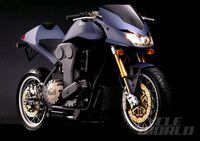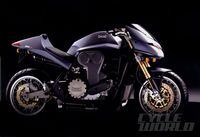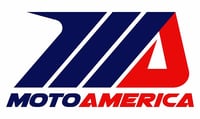From the July 2000 issue of Cycle World.
The current crop of 600cc sportbikes are the most versatile, capable motorcycles of our time. Interesting smaller-displacement streetbikes don't really exist, and bigger machines gain weight and lose handiness. The rockets–Honda's CBR1100XX, Kawasaki's ZX-12R and Suzuki's Hayabusa–are more like utility-power stations on hollow-spoke wheels, appealing to those who wish to simulate the top-end kick of oxy-hydrogen third-stage engines. Do they define the edge of the known universe?
They do not. In that Great Beyond, an Australian group has built a 300-cubic-inch V-Twin, based on a pair of aircraft engine cylinders. And Friedel Münch is at it again.
Older riders remember the vast 1200cc Münch Mammut (mammoth) of the Sixties, powered by an NSU car engine, and braked by a sitzbath-sized drum. Earlier this year, this quiet, persistent man and his new backers unleashed a fresh hugeness–the 260-horsepower, 779-pound Mammut 2000.
The 86 x 86mm, 1998cc transverse four-cylinder engine features a 16-valve Cosworth cylinder head. It is turbo-charged at 13 psi to satisfy those who wonder why Herr Münch didn't make it bigger. Peak power is given at only 5650 rpm, although the engine can safely rev to 8500. Electronically limited to 156 mph to satisfy the gray men in Brussels, this bike would otherwise top out in sixth gear at a modest 172 mph (go ahead, cut that red wire, and bolt that dinky 30-tooth sprocket on the back–we dare you!). Acceleration, according to the brochure, is "sufficient."
Suspension is 43mm Öhlins at the front, dual WP under-engine units at the rear. Braking is handled by maximal twin 320mm discs at the front, grasped by a pair of eight-piston calipers. The chassis is retro-conventional twin-loop steel, with conservative geometry of 28 degrees of rake, 4.5 inches of trail.
This giant satisfies European D4 emissions standards, thanks to automotive-style closed-loop Motronic fuel injection and a rapid-lightup metal-substrate catalytic converter. Using an accessory cable, factory technicians can address the onboard computer over the Internet, and analyze important functions. Ve have ze technology.
All this is yours for a cool $82,000.













/cloudfront-us-east-1.images.arcpublishing.com/octane/WVYKJFMINVFMFH37AE4OUEWVIM.jpg)

/cloudfront-us-east-1.images.arcpublishing.com/octane/JJ3MC6GNDFF5ZNYD3KD3E4EY7Y.jpg)
/cloudfront-us-east-1.images.arcpublishing.com/octane/XH2ETEU4NVGDFNQO2XT2QQS5LU.jpg)
/cloudfront-us-east-1.images.arcpublishing.com/octane/UFG652C27BDBFPK42TDAJ5CMX4.jpg)
/cloudfront-us-east-1.images.arcpublishing.com/octane/AUE3NFVRRZDSBIDVUGIYIDQNUI.jpg)
/cloudfront-us-east-1.images.arcpublishing.com/octane/LYR62CH2WNBMHJJVXVATZHOUE4.jpg)
/cloudfront-us-east-1.images.arcpublishing.com/octane/RBCTRGBQYBDK7A6XPG3HKPS7ZQ.jpg)
/cloudfront-us-east-1.images.arcpublishing.com/octane/MQXQRYMZVBCWJIRYP3HEN3SHVE.jpg)
/cloudfront-us-east-1.images.arcpublishing.com/octane/TSPODNNEWRDSVJGUCNQTDG4ADI.jpg)
/cloudfront-us-east-1.images.arcpublishing.com/octane/X5TB7BDV4BA2RPSY54ZGK27RP4.jpg)
/cloudfront-us-east-1.images.arcpublishing.com/octane/REUHOJXRDBGZ5IHBYZCCBCISPA.jpg)
/cloudfront-us-east-1.images.arcpublishing.com/octane/52LGJTCKBFEHDF7S7H4CVUIMGM.jpg)
/cloudfront-us-east-1.images.arcpublishing.com/octane/YMWAIPIPSJAOXOU3QMJMGH37OM.jpg)


/cloudfront-us-east-1.images.arcpublishing.com/octane/EJ6KZRGAYBCVXNL2PJXL37UVWQ.jpg)
/cloudfront-us-east-1.images.arcpublishing.com/octane/AAN4TI76M5H5JMUVEIGASWXBDU.jpg)
/cloudfront-us-east-1.images.arcpublishing.com/octane/P3RXD2UCPFF37CMB7CHPVKXORY.jpg)
/cloudfront-us-east-1.images.arcpublishing.com/octane/VZEG2EJI2RDFZNHLRZMU56MD3Q.jpg)
/cloudfront-us-east-1.images.arcpublishing.com/octane/GVJQO5FFOFBWNGODOBRB4FBAW4.jpg)
/cloudfront-us-east-1.images.arcpublishing.com/octane/BIVAK2SFIBDJJM25E7I5VU2FJE.jpg)
/cloudfront-us-east-1.images.arcpublishing.com/octane/CH5VX52UG5CFHOVH5A6UYEFWWA.jpg)
/cloudfront-us-east-1.images.arcpublishing.com/octane/ZVGJNGZRU5C33N7KN23BBFKSC4.jpg)